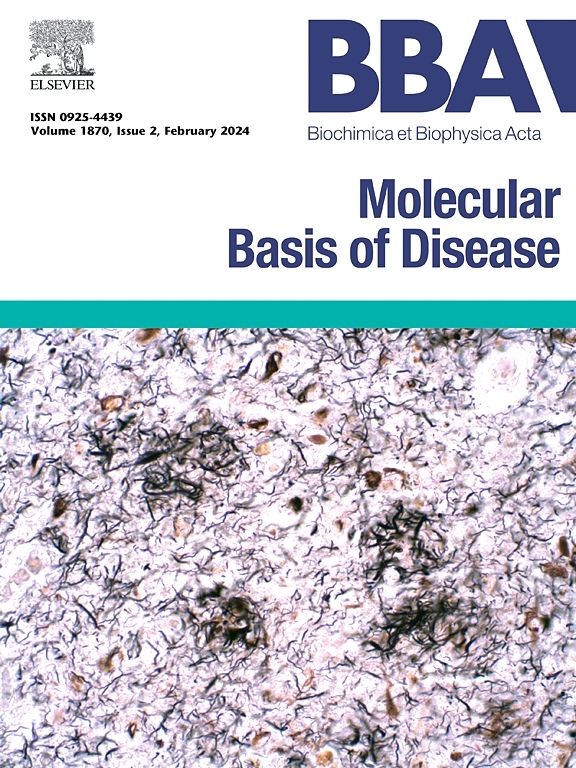ALDH2的缺失通过4-HNE/ERK1/2-p16INK4a信号通路加速肺动脉高压的进展
IF 4.2
2区 生物学
Q2 BIOCHEMISTRY & MOLECULAR BIOLOGY
Biochimica et biophysica acta. Molecular basis of disease
Pub Date : 2025-04-22
DOI:10.1016/j.bbadis.2025.167863
引用次数: 0
摘要
衰老是导致肺动脉高压(PAH)发生的重要因素。醛脱氢酶2 (ALDH2)是一种参与醛解毒的酶,在与醛积累相关的心血管疾病中起作用。本研究旨在探讨ALDH2在缺氧诱导的肺动脉平滑肌细胞(PASMCs)和PAH中的作用。将ALDH2敲除(ALDH2−/−)小鼠和野生型(WT)小鼠暴露于氧浓度为10±0.5%的缺氧环境中4周,建立慢性缺氧诱导的PAH (HPH)小鼠模型。我们发现,与WT小鼠相比,ALDH2−/−小鼠右室肥厚和肺小动脉肌肉化更为严重。此外,与WT小鼠相比,ALDH2−/−小鼠表现出4-HNE、p-ERK1/2、衰老相关蛋白p16INK4a和衰老相关分泌表型(SASP)的表达水平升高。同样,使用ALDH2抑制剂(Daidzin)治疗可显著增加缺氧PASMCs中4-HNE、p-ERK1/2、p16INK4a和SASP水平。相反,ALDH2的过表达减少了4-HNE、p-ERK1/2和PASMC的衰老。此外,外源性4-HNE用于模拟缺氧条件,激活ERK信号通路,诱导PASMC衰老。然而,erk特异性抑制剂(PD98059)阻断了缺氧诱导的PASMC衰老。这些结果表明,在HPH中,ALDH2缺乏通过4-HNE/ERK1/2-p16INK4a信号通路诱导PASMC衰老并促进肺血管重塑,为PAH治疗提供了新的靶点。本文章由计算机程序翻译,如有差异,请以英文原文为准。
Loss of ALDH2 accelerates the progression of pulmonary arterial hypertension through the 4-HNE/ERK1/2-p16INK4a signaling pathway
Senescence is an important causative factor in the development of pulmonary arterial hypertension (PAH). Aldehyde dehydrogenase 2 (ALDH2), an enzyme involved in aldehyde detoxification, plays a role in cardiovascular diseases associated with aldehyde accumulation. This study aimed to investigate the role of ALDH2 in hypoxia-induced pulmonary arterial smooth muscle cells (PASMCs) and PAH. ALDH2 knockout (ALDH2−/−) mice and wild-type (WT) mice were exposed to a hypoxic environment with 10 ± 0.5 % oxygen concentration for 4 weeks to develop a chronic hypoxia-induced PAH (HPH) mouse model. We found that right ventricular hypertrophy and pulmonary arteriole muscularization were more severe in ALDH2−/− mice compared to WT mice. Additionally, ALDH2−/− mice exhibited elevated expression levels of 4-HNE, p-ERK1/2, the senescence-related protein p16INK4a, and the senescence-associated secretory phenotype (SASP) compared to WT mice. Similarly, treatment with the ALDH2 inhibitor (Daidzin) significantly increased 4-HNE, p-ERK1/2, p16INK4a, and SASP levels in PASMCs under hypoxia. Conversely, overexpression of ALDH2 reduced 4-HNE, p-ERK1/2, and PASMC senescence. Furthermore, exogenous 4-HNE, used to simulate hypoxia conditions, activated the ERK signaling pathway and induced PASMC senescence. However, ERK-specific inhibitors (PD98059) blocked hypoxia-induced PASMC senescence. These results demonstrate that ALDH2 deficiency induces PASMC senescence and promotes pulmonary vascular remodeling through the 4-HNE/ERK1/2-p16INK4a signaling pathway in HPH, providing a novel target for PAH treatment.
求助全文
通过发布文献求助,成功后即可免费获取论文全文。
去求助
来源期刊
CiteScore
12.30
自引率
0.00%
发文量
218
审稿时长
32 days
期刊介绍:
BBA Molecular Basis of Disease addresses the biochemistry and molecular genetics of disease processes and models of human disease. This journal covers aspects of aging, cancer, metabolic-, neurological-, and immunological-based disease. Manuscripts focused on using animal models to elucidate biochemical and mechanistic insight in each of these conditions, are particularly encouraged. Manuscripts should emphasize the underlying mechanisms of disease pathways and provide novel contributions to the understanding and/or treatment of these disorders. Highly descriptive and method development submissions may be declined without full review. The submission of uninvited reviews to BBA - Molecular Basis of Disease is strongly discouraged, and any such uninvited review should be accompanied by a coverletter outlining the compelling reasons why the review should be considered.

 求助内容:
求助内容: 应助结果提醒方式:
应助结果提醒方式:


